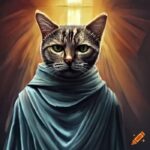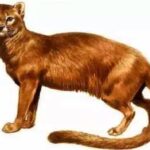For the most part, cats have been sidelined in adult literature, making appearances as major players largely in books for children. Some literary cats are more realistic than others, but even the most fantastic usually have qualities that are instantly recognizable as feline. Often, the creators of fictional cats have used their own pets as a source of inspiration.
Table of Contents
Classic Cats
Many cat stories and poems have become accepted as classics, losing nothing of their timeless appeal through translation into dozens of different languages and countless editions. One of the most famous of all fictional felines is the Cheshire Cat in Lewis Carroll’s Alice’s Adventures in Wonderland (1865), the book that changed children’s literature forever.
This maddening and slightly eerie animal with its semidetached grin makes Alice “quite giddy” as it appears and evaporates at will. The proverbial expression “grinning like a Cheshire cat” was not coined by Carroll, and is known to predate Alice by more than half a century. Other cats—normal ones—have minor roles in the second Alice story, Through the Looking-Glass (1871), and a mischievous black kitten gets blamed for the adventure.
The cats and kittens in Beatrix Potter’s tales were based on the cats that lived in and around the author’s farmhouse in the English Lake District, but their characters probably owed something to the children she knew. In The Tale of Tom Kitten (1907), Tom and his sisters end up in disgrace for ruining their best clothes.
But Tom fares even worse in The Tale of Samuel Whiskers (1908), when he is covered with dough and made into a “roly-poly pudding,” destined to be dinner for a pair of rats. Potter’s cats—among them, Tom, Tabitha, Miss Moppet, Simpkin from The Tailor of Gloucester (1903), and the inefficient shopkeeper Ginger—have shared their familiar names with countless pets.
“The Cat that Walked by Himself,” in Rudyard Kipling’s Just So Stories (1902), is cool, calculating, and self-possessed. “Waving his wild tail and walking by his wild lone,” he cleverly persuades a human family to give him a place at the fireside. Unlike the already domesticated dog, horse, and cow, this cat is no friend, servant, or provider, but he knows how to honor a bargain and yet keep his independence.
A modern book that has achieved nearclassic status both in Britain and the United States is Barbara Sleigh’s Carbonel (1955), the story of a royal cat stolen from his rightful kingdom by a witch. Carbonel is arrogant and touchy, and the two children who help him to regain his throne, getting mixed up with magic and catfights along the way, find him a sometimes-trying companion. Sleigh wrote two, less-acclaimed, sequels concerning the adventures of Carbonel’s offspring.
The Cat in the Hat, the comical creation of Theodor Giesel, who wrote as Dr. Seuss, has taught generations of young children to read. First published in the United States in the 1950s and still going strong, this is one of several books featuring the scraggy anthropomorphic Cat, absurdly dressed in a scarf and a tall, striped hat. A positive lord of misrule, the Cat, whose exploits are told in simple, cantering rhymes, causes wreckage and mayhem just to provide amusement for a couple of bored children on a rainy day.
 Behemoth, the colossal black cat that stalks on two legs through Bulgakov’s satire The Master and Margarita, is a not-very-well-respected servant of the Devil. He is named after the monster described in the Bible’s Book of Job.
Behemoth, the colossal black cat that stalks on two legs through Bulgakov’s satire The Master and Margarita, is a not-very-well-respected servant of the Devil. He is named after the monster described in the Bible’s Book of Job.
Demons and Detectives
In fiction for adult readers, cats as major characters are rare. Of the few memorable examples, there can be none more frightful than the gigantic, demonic, gunslinging Behemoth in Mikhail Bulgakov’s chaotic and witty satire The Master and Margarita (published posthumously in 1967). And for sheer horror, there is little to beat Edgar Allan Poe’s short story “The Black Cat” (1843), in which a murdered cat haunts the drunken master who killed it.
A subgenre of the detective novel with a feline twist has become immensely popular in recent decades. Known loosely as “cat mysteries,” series after series of books, mostly variations on the theme of the small-town amateur sleuth with a canny cat partner, have been flooding bookshelves alongside conventional crime fiction.
Cats in Poetry
Poets rather than novelists have found inspiration in cats. Thomas Gray mourned a pet in “Ode on the Death of a Favorite Cat Drowned in a Tub of Gold Fishes” (1748), while John Keats in “Sonnet to a Cat” (c.1818) paid affectionate tribute to a battered and asthmatic old reprobate, and William Wordsworth (1770–1850) was moved to versify about a kitten playing with leaves.
More likely to be quoted than any of these is Edward Lear’s nonsense rhyme “The Owl and the Pussycat” (1871), or the best-known modern cat poems collected in Old Possum’s Book of Practical Cats (1939) by T. S. Eliot. Like Lear, Eliot was writing for children, but his shrewd and amusing portrayals of feline personalities are enjoyed by all ages.
The Writer’s Muse
Many writers, Eliot included, have kept cats for company in their solitary working lives. The favorite of Dr. Samuel Johnson, famed for his English dictionary (1755), was Hodge, who is immortalized in a statue outside Johnson’s house in London.
In his novels, Charles Dickens (1812–70) sees cats as fit associates for some of his nastier characters, but he was nevertheless a cat lover, apparently keeping the stuffed paw of a much-missed pet on his desk. Ernest Hemingway (1899–1961) did not stuff a paw from his six-toed cat Snowball, but her descendants live on as tourist attractions at the writer’s house, now a museum, in Key West, Florida.
 Writer and cat lover Ernest Hemingway kept polydactyl (extra-toed) cats at his home on Key West, Florida. Some 40 or 50 of their descendants, many of them polydactyl, live around what is now the Hemingway Museum.
Writer and cat lover Ernest Hemingway kept polydactyl (extra-toed) cats at his home on Key West, Florida. Some 40 or 50 of their descendants, many of them polydactyl, live around what is now the Hemingway Museum.











